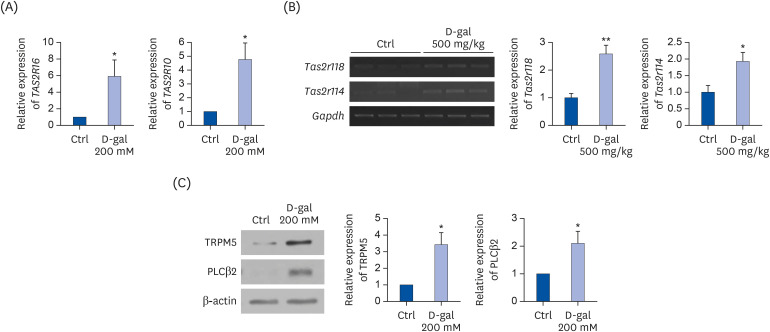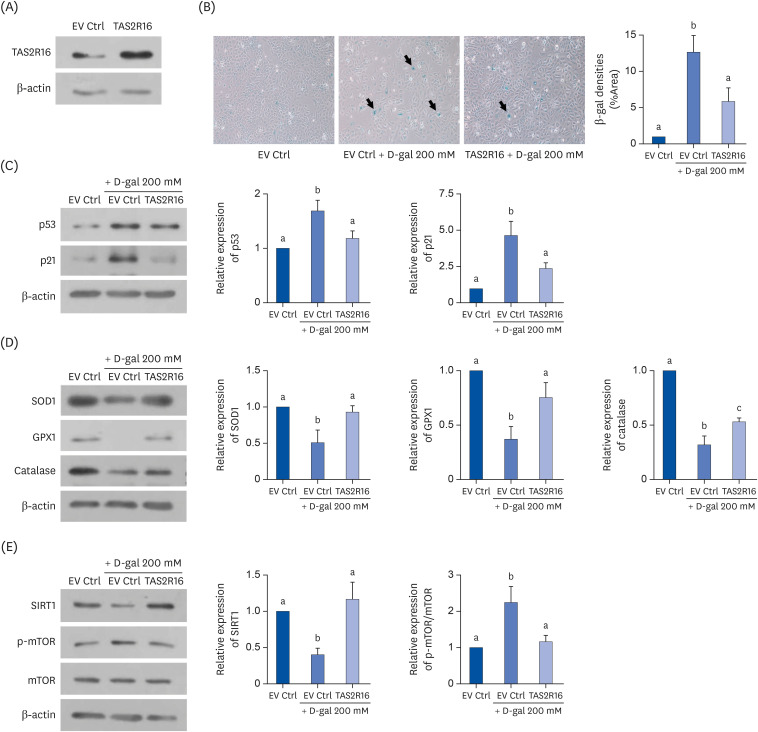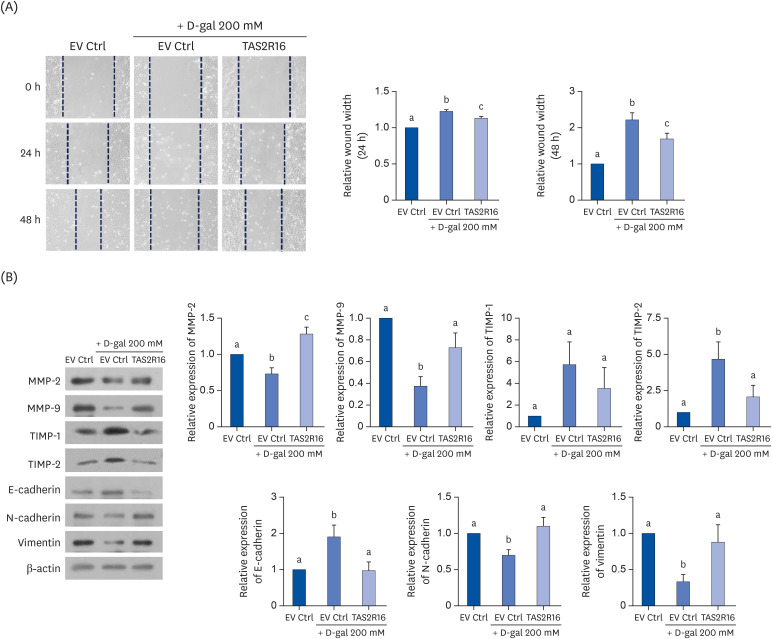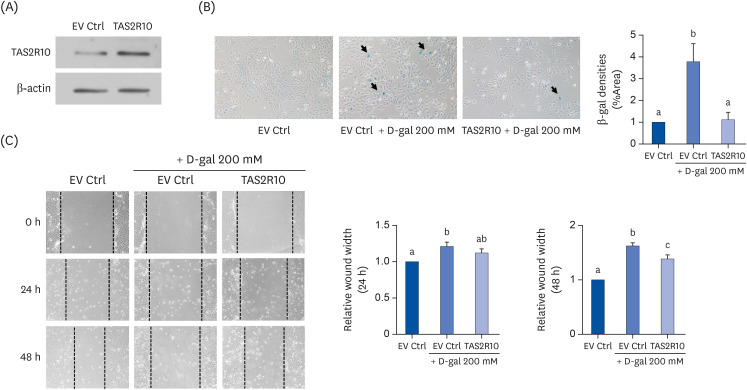1. Zhang Y, Hoon MA, Chandrashekar J, Mueller KL, Cook B, Wu D, Zuker CS, Ryba NJ. Coding of sweet, bitter, and umami tastes: different receptor cells sharing similar signaling pathways. Cell. 2003; 112:293–301. PMID:
12581520.
2. Meyerhof W, Batram C, Kuhn C, Brockhoff A, Chudoba E, Bufe B, Appendino G, Behrens M. The molecular receptive ranges of human TAS2R bitter taste receptors. Chem Senses. 2010; 35:157–170. PMID:
20022913.

3. Carey RM, Adappa ND, Palmer JN, Lee RJ, Cohen NA. Taste receptors: regulators of sinonasal innate immunity. Laryngoscope Investig Otolaryngol. 2016; 1:88–95.

4. Seo Y, Kim YS, Lee KE, Park TH, Kim Y. Anti-cancer stemness and anti-invasive activity of bitter taste receptors, TAS2R8 and TAS2R10, in human neuroblastoma cells. PLoS One. 2017; 12:e0176851. PMID:
28467517.

5. Shaw L, Mansfield C, Colquitt L, Lin C, Ferreira J, Emmetsberger J, Reed DR. Personalized expression of bitter ‘taste’ receptors in human skin. PLoS One. 2018; 13:e0205322. PMID:
30332676.

6. Farage MA, Miller KW, Elsner P, Maibach HI. Characteristics of the aging skin. Adv Wound Care (New Rochelle). 2013; 2:5–10. PMID:
24527317.

7. Cosgrove MC, Franco OH, Granger SP, Murray PG, Mayes AE. Dietary nutrient intakes and skin-aging appearance among middle-aged American women. Am J Clin Nutr. 2007; 86:1225–1231. PMID:
17921406.

8. Zhao P, Sui BD, Liu N, Lv YJ, Zheng CX, Lu YB, Huang WT, Zhou CH, Chen J, Pang DL, Fei DD, Xuan K, Hu CH, Jin Y. Anti-aging pharmacology in cutaneous wound healing: effects of metformin, resveratrol, and rapamycin by local application. Aging Cell. 2017; 16:1083–1093. PMID:
28677234.

9. Barriere G, Fici P, Gallerani G, Fabbri F, Rigaud M. Epithelial mesenchymal transition: a double-edged sword. Clin Transl Med. 2015; 4:14. PMID:
25932287.

10. Arpino V, Brock M, Gill SE. The role of TIMPs in regulation of extracellular matrix proteolysis. Matrix Biol. 2015; 44-46:247–254. PMID:
25805621.

11. Song X, Bao M, Li D, Li YM. Advanced glycation in D-galactose induced mouse aging model. Mech Ageing Dev. 1999; 108:239–251. PMID:
10405984.

12. Van Putte L, De Schrijver S, Moortgat P. The effects of advanced glycation end products (AGEs) on dermal wound healing and scar formation: a systematic review. Scars Burn Heal. 2016; 2:2059513116676828. PMID:
29799552.

13. Wang ZL, Chen LB, Qiu Z, Chen XB, Liu Y, Li J, Wang L, Wang YP. Ginsenoside Rg1 ameliorates testicular senescence changes in D-gal-induced aging mice via anti-inflammatory and antioxidative mechanisms. Mol Med Rep. 2018; 17:6269–6276. PMID:
29512726.
14. Li H, Zheng L, Chen C, Liu X, Zhang W. Brain senescence caused by elevated levels of reactive metabolite methylglyoxal on D-galactose-induced aging mice. Front Neurosci. 2019; 13:1004. PMID:
31619960.

15. Chen P, Chen F, Lei J, Li Q, Zhou B. Activation of the miR-34a-mediated SIRT1/mTOR signaling pathway by urolithin A attenuates D-galactose-induced brain aging in mice. Neurotherapeutics. 2019; 16:1269–1282. PMID:
31420820.

16. Xu C, Huang X, Tong Y, Feng X, Wang Y, Wang C, Jiang Y. Icariin modulates the sirtuin/NF-κB pathway and exerts anti-aging effects in human lung fibroblasts. Mol Med Rep. 2020; 22:3833–3839. PMID:
33000191.

17. Campa D, De Rango F, Carrai M, Crocco P, Montesanto A, Canzian F, Rose G, Rizzato C, Passarino G, Barale R. Bitter taste receptor polymorphisms and human aging. PLoS One. 2012; 7:e45232. PMID:
23133589.

18. Melis M, Errigo A, Crnjar R, Pes GM, Tomassini Barbarossa I. TAS2R38 bitter taste receptor and attainment of exceptional longevity. Sci Rep. 2019; 9:18047. PMID:
31792278.

19. Behrens M, Brockhoff A, Batram C, Kuhn C, Appendino G, Meyerhof W. The human bitter taste receptor hTAS2R50 is activated by the two natural bitter terpenoids andrographolide and amarogentin. J Agric Food Chem. 2009; 57:9860–9866. PMID:
19817411.

20. Disasa D, Cheng L, Manzoor M, Liu Q, Wang Y, Xiang L, Qi J. Amarogentin from
Gentiana rigescens Franch exhibits antiaging and neuroprotective effects through antioxidative stress. Oxid Med Cell Longev. 2020; 2020:3184019. PMID:
32831994.
21. Pronin AN, Xu H, Tang H, Zhang L, Li Q, Li X. Specific alleles of bitter receptor genes influence human sensitivity to the bitterness of aloin and saccharin. Curr Biol. 2007; 17:1403–1408. PMID:
17702579.

22. Zhong J, Wang F, Wang Z, Shen C, Zheng Y, Ma F, Zhu T, Chen L, Tang Q, Zhu J. Aloin attenuates cognitive impairment and inflammation induced by d-galactose via down-regulating ERK, p38 and NF-κB signaling pathway. Int Immunopharmacol. 2019; 72:48–54. PMID:
30959371.

23. Guo F, Wu R, Xu J. Salicin prevents TNF-α-induced cellular senescence in human umbilical vein endothelial cells (HUVECs). Artif Cells Nanomed Biotechnol. 2019; 47:2618–2623. PMID:
31220953.

24. Zhai KF, Duan H, Khan GJ, Xu H, Han FK, Cao WG, Gao GZ, Shan LL, Wei ZJ. Salicin from Alangium chinense ameliorates rheumatoid arthritis by modulating the Nrf2-HO-1-ROS pathways. J Agric Food Chem. 2018; 66:6073–6082. PMID:
29852739.

25. Tran TA, Ho MT, Song YW, Cho M, Cho SK. Camphor induces proliferative and anti‐senescence activities in human primary dermal fibroblasts and inhibits UV‐induced wrinkle formation in mouse skin. Phytother Res. 2015; 29:1917–1925. PMID:
26458283.

26. Lee NY, Kim Y, Kim YS, Shin JH, Rubin LP, Kim Y. β-Carotene exerts anti-colon cancer effects by regulating M2 macrophages and activated fibroblasts. J Nutr Biochem. 2020; 82:108402. PMID:
32450500.

27. Eppig JT. Mouse genome informatics (MGI) resource: genetic, genomic, and biological knowledgebase for the laboratory mouse. ILAR J. 2017; 58:17–41. PMID:
28838066.

28. Mouse Genome Informatics (MGI). MGI homepage [Internet]. [place unknown]: MGI;2020. cited 2020 October 3. Available from:
http://www.informatics.jax.org.
31. Zhang Y, Wang J, Cheng X, Yi B, Zhang X, Li Q. Apigenin induces dermal collagen synthesis via smad2/3 signaling pathway. Eur J Histochem. 2015; 59:2467. PMID:
26150153.

32. Ye Y, Jia RR, Tang L, Chen F.
In vivo antioxidant and anti-skin-aging activities of ethyl acetate extraction from idesia polycarpa defatted fruit residue in aging mice induced by D-galactose. Evid Based Complement Alternat Med. 2014; 2014:185716. PMID:
24971146.
33. Chen J, Li Y, Zhu Q, Li T, Lu H, Wei N, Huang Y, Shi R, Ma X, Wang X, Sheng J. Anti-skin-aging effect of epigallocatechin gallate by regulating epidermal growth factor receptor pathway on aging mouse model induced by D-galactose. Mech Ageing Dev. 2017; 164:1–7. PMID:
28343910.
34. Liu Z, Hu GD, Luo XB, Yin B, Shu B, Guan JZ, Jia CY. Potential of bone marrow mesenchymal stem cells in rejuvenation of the aged skin of rats. Biomed Rep. 2017; 6:279–284. PMID:
28451386.

35. Grassin-Delyle S, Salvator H, Mantov N, Abrial C, Brollo M, Faisy C, Naline E, Couderc LJ, Devillier P. Bitter taste receptors (TAS2Rs) in human lung macrophages: receptor expression and inhibitory effects of TAS2R agonists. Front Physiol. 2019; 10:1267. PMID:
31632299.

36. Orsmark-Pietras C, James A, Konradsen JR, Nordlund B, Söderhäll C, Pulkkinen V, Pedroletti C, Daham K, Kupczyk M, Dahlén B, Kere J, Dahlén SE, Hedlin G, Melén E. Transcriptome analysis reveals upregulation of bitter taste receptors in severe asthmatics. Eur Respir J. 2013; 42:65–78. PMID:
23222870.

37. Xu H, Gan C, Gao Z, Huang Y, Wu S, Zhang D, Wang X, Sheng J. Caffeine targets SIRT3 to enhance SOD2 activity in mitochondria. Front Cell Dev Biol. 2020; 8:822. PMID:
33015038.

38. Mazumder A, Dwivedi A, du Preez JL, du Plessis J.
In vitro wound healing and cytotoxic effects of sinigrin-phytosome complex. Int J Pharm. 2016; 498:283–293. PMID:
26706438.
39. Lee HJ, Hwang E, Park B, Zhang M, Sun ZW, Lee DG, Park SY, Yi TH. Methanol extract of bitter melon alleviates UVB-induced MMPs expression via MAP kinase and AP-1 signaling in human dermal fibroblasts
in vitro
. Phytother Res. 2016; 30:1519–1526. PMID:
27335129.
40. Apraj VD, Pandita NS. Evaluation of skin anti-aging potential of Citrus reticulata blanco peel. Pharmacognosy Res. 2016; 8:160–168. PMID:
27365982.

41. Li T, Yang S, She X, Yan Q, Zhang P, Zhu H, Wang F, Luo X, Sun X. Modulation of α-adrenoceptor signalling protects photoreceptors after retinal detachment by inhibiting oxidative stress and inflammation. Br J Pharmacol. 2019; 176:801–813. PMID:
30588605.

42. Chen WM, Chiang JC, Lin YC, Lin YN, Chuang PY, Chang YC, Chen CC, Wu KY, Hsieh JC, Chen SK, Huang WP, Chen BP, Lee H. Lysophosphatidic acid receptor LPA
3 prevents oxidative stress and cellular senescence in Hutchinson-Gilford progeria syndrome. Aging Cell. 2020; 19:e13064. PMID:
31714004.

43. Kim Y, Kim E, Kim Y. l-histidine and l-carnosine accelerate wound healing via regulation of corticosterone and PI3K/Akt phosphorylation in d-galactose-induced aging models in vitro and in vivo
. J Funct Foods. 2019; 58:227–237.
44. Montesinos MC, Gadangi P, Longaker M, Sung J, Levine J, Nilsen D, Reibman J, Li M, Jiang CK, Hirschhorn R, Recht PA, Ostad E, Levin RI, Cronstein BN. Wound healing is accelerated by agonists of adenosine A2 (G α s-linked) receptors. J Exp Med. 1997; 186:1615–1620. PMID:
9348321.
45. Braun M, Lelieur K, Kietzmann M. Purinergic substances promote murine keratinocyte proliferation and enhance impaired wound healing in mice. Wound Repair Regen. 2006; 14:152–161. PMID:
16630104.

46. Zhu H, Liu L, Ren L, Ma J, Hu S, Zhu Z, Zhao X, Shi C, Wang X, Zhang C, Gu M, Li X. Systematic prediction of the biological functions of TAS2R10 using positive co-expression analysis. Exp Ther Med. 2020; 19:1733–1738. PMID:
32104227.

47. Li YF, Ouyang SH, Tu LF, Wang X, Yuan WL, Wang GE, Wu YP, Duan WJ, Yu HM, Fang ZZ, Kurihara H, Zhang Y, He RR. Caffeine protects skin from oxidative stress-induced senescence through the activation of autophagy. Theranostics. 2018; 8:5713–5730. PMID:
30555576.

48. Shil A, Olusanya O, Ghufoor Z, Forson B, Marks J, Chichger H. Artificial sweeteners disrupt tight junctions and barrier function in the intestinal epithelium through activation of the sweet taste receptor, T1R3. Nutrients. 2020; 12:1862.

49. Wauson EM, Zaganjor E, Lee AY, Guerra ML, Ghosh AB, Bookout AL, Chambers CP, Jivan A, McGlynn K, Hutchison MR, Deberardinis RJ, Cobb MH. The G protein-coupled taste receptor T1R1/T1R3 regulates mTORC1 and autophagy. Mol Cell. 2012; 47:851–862. PMID:
22959271.









 PDF
PDF Citation
Citation Print
Print



 XML Download
XML Download